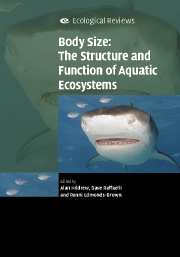Book contents
- Frontmatter
- Contents
- List of contributors
- Preface
- 1 The metabolic theory of ecology and the role of body size in marine and freshwater ecosystems
- 2 Body size and suspension feeding
- 3 Life histories and body size
- 4 Relationship between biomass turnover and body size for stream communities
- 5 Body size in streams: macroinvertebrate community size composition along natural and human-induced environmental gradients
- 6 Body size and predatory interactions in freshwaters: scaling from individuals to communities
- 7 Body size and trophic cascades in lakes
- 8 Body size and scale invariance: multifractals in invertebrate communities
- 9 Body size and biogeography
- 10 By wind, wings or water: body size, dispersal and range size in aquatic invertebrates
- 11 Body size and diversity in marine systems
- 12 Interplay between individual growth and population feedbacks shapes body-size distributions
- 13 The consequences of body size in model microbial ecosystems
- 14 Body size, exploitation and conservation of marine organisms
- 15 How body size mediates the role of animals in nutrient cycling in aquatic ecosystems
- 16 Body sizes in food chains of animal predators and parasites
- 17 Body size in aquatic ecology: important, but not the whole story
- Index
- References
13 - The consequences of body size in model microbial ecosystems
Published online by Cambridge University Press: 02 December 2009
- Frontmatter
- Contents
- List of contributors
- Preface
- 1 The metabolic theory of ecology and the role of body size in marine and freshwater ecosystems
- 2 Body size and suspension feeding
- 3 Life histories and body size
- 4 Relationship between biomass turnover and body size for stream communities
- 5 Body size in streams: macroinvertebrate community size composition along natural and human-induced environmental gradients
- 6 Body size and predatory interactions in freshwaters: scaling from individuals to communities
- 7 Body size and trophic cascades in lakes
- 8 Body size and scale invariance: multifractals in invertebrate communities
- 9 Body size and biogeography
- 10 By wind, wings or water: body size, dispersal and range size in aquatic invertebrates
- 11 Body size and diversity in marine systems
- 12 Interplay between individual growth and population feedbacks shapes body-size distributions
- 13 The consequences of body size in model microbial ecosystems
- 14 Body size, exploitation and conservation of marine organisms
- 15 How body size mediates the role of animals in nutrient cycling in aquatic ecosystems
- 16 Body sizes in food chains of animal predators and parasites
- 17 Body size in aquatic ecology: important, but not the whole story
- Index
- References
Summary
Introduction
Patterns in the sizes of coexisting organisms have always intrigued ecologists (Hutchinson, 1961). Some kinds of regularities are well known for some systems (Sheldon, Prakash & Sutcliffe, 1972), and are less appreciated or rediscovered for others (Enquist & Niklas, 2001; Cohen, Jonsson & Carpenter, 2003). One example of this kind of pattern is the apparent constancy of total biomass within different size fractions of organisms living in aquatic communities (Sheldon, et al. 1972; Cyr, 2000; Kerr & Dickie, 2001; Cohen et al., 2003; Sheldon, Sutcliffe & Paranjape, 1977; Tilman et al., 2001; Mulder et al., 2005). Essentially, over many orders of magnitude of organism size, any particular size class holds about the same total biomass of organisms per unit volume. The result is an inverse relationship between the log of organism size and the log of organism abundance per unit volume, with a slope of − 1. The apparent constancy of this relationship has even led some workers to suggest, tongue in cheek, that it could be used to estimate the population size of some organisms that have proven to be notoriously difficult to observe, once assumptions about their average size were made (Sheldon & Kerr, 1972, 1973). Whether or not the elusive Loch Ness Monster (to which these calculations were rather whimsically applied) actually exists, it appears that the total biomass of organisms in some habitats is fixed by certain features of the habitat, most likely the abundance of incoming energy and nutrients that drive productivity (Sheldon et al., 1977; Cyr, 2000; Kerr & Dickie, 2001; Cohen et al., 2003; Mulder et al., 2005).
- Type
- Chapter
- Information
- Body Size: The Structure and Function of Aquatic Ecosystems , pp. 245 - 265Publisher: Cambridge University PressPrint publication year: 2007
References
- 3
- Cited by

